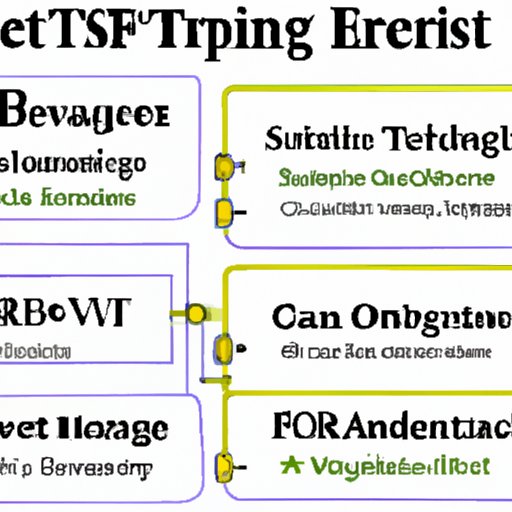Introduction
Exchange-traded funds (ETFs) are gaining popularity as a way to diversify an investor’s portfolio. ETFs are investment funds that trade on stock exchanges and can be made up of stocks, bonds, or other assets. They provide investors with a convenient way to access different asset classes with one purchase. In this article, we’ll explore how to invest in ETFs and the benefits they offer.
Analyze Different Types of ETFs
The first step to investing in ETFs is to research what’s available. There are thousands of ETFs out there, so it’s important to narrow down your search. Start by looking at ETFs that track different indexes, such as the S&P 500 or the Dow Jones Industrial Average. You can also look at sector ETFs, which focus on specific industries like technology or energy. Finally, consider actively managed ETFs, which are managed by professionals who make decisions about which securities to buy and sell.
Once you’ve identified the types of ETFs that interest you, it’s time to assess which ones are best for your investment goals. Consider the fees associated with each ETF, as well as its performance history. According to a study by the Financial Industry Regulatory Authority, “ETFs have lower expense ratios than similar mutual funds, making them a more cost-effective option for investors.” Make sure to compare the costs and performance of different ETFs before making a decision.
Assess Risk Tolerance
Before investing in any kind of security, it’s important to understand your risk tolerance. Risk tolerance is the amount of risk you’re willing to take when investing. Some people are comfortable taking on more risk, while others prefer a more conservative approach. Knowing your risk tolerance will help you choose the right ETFs for your portfolio.
The next step is to use your risk tolerance to guide your ETF selection. If you’re a more conservative investor, you might want to focus on ETFs that track broad-based indexes, such as the S&P 500. On the other hand, if you’re comfortable taking on more risk, you may want to look at sector-specific ETFs or actively managed ETFs.
Choose ETF Brokerage Platform
Once you’ve identified the ETFs you’d like to invest in, you’ll need to select a brokerage platform. Most major banks and online brokers offer ETF trading, so you’ll want to compare the fees and features of different platforms before making a decision. Some platforms offer commission-free trades, while others charge a fee for each transaction. Choose a platform that meets your needs and fits within your budget.
Once you’ve chosen a broker, you’ll need to open an account. When opening an account, you’ll need to provide information about yourself, such as your name, address, and Social Security number. You’ll also need to fund your account with money from your bank account or credit card. Once your account is set up, you’ll be able to access the ETFs you want to buy and sell.
Set Investment Goals
Now that you’ve chosen a brokerage platform and identified the ETFs you want to invest in, it’s time to set your investment goals. Before investing, decide how much money you’d like to allocate to each ETF. This will depend on your risk tolerance and long-term financial goals. It’s important to remember that investing in ETFs involves some degree of risk and you could lose money. So, it’s important to set realistic expectations for returns.
When setting your investment goals, think about the time frame you’d like to invest over. Are you investing for the short term or the long term? If you’re investing for the long term, you may want to choose ETFs that track broad-based indexes or hold a mix of stocks and bonds. If you’re investing for the short term, you may want to focus on sector-specific ETFs or actively managed ETFs.
Monitor Investments
Once you’ve invested in ETFs, it’s important to monitor your investments closely. Keep an eye on the performance of the ETFs you’ve purchased and make changes as necessary. If an ETF is underperforming, you may want to consider selling it and replacing it with a different one. On the other hand, if an ETF is performing well, you may want to buy more shares.
It’s also important to review your portfolio periodically and make sure it still aligns with your investment goals. As your financial situation changes, you may need to adjust your portfolio accordingly. For example, if you get a raise or have a change in income, you may need to reallocate money to different ETFs.
Conclusion
Investing in ETFs can be a great way to diversify your portfolio and access different asset classes with one purchase. To get started, research the different types of ETFs available, assess your risk tolerance, choose a brokerage platform, set investment goals, and monitor your investments closely. By following these steps, you can ensure that you’re investing in the right ETFs for your needs.
The benefits of investing in ETFs include lower fees, greater diversification, and access to a wide range of asset classes. With careful research and monitoring, ETFs can be a great addition to any portfolio.
(Note: Is this article not meeting your expectations? Do you have knowledge or insights to share? Unlock new opportunities and expand your reach by joining our authors team. Click Registration to join us and share your expertise with our readers.)
